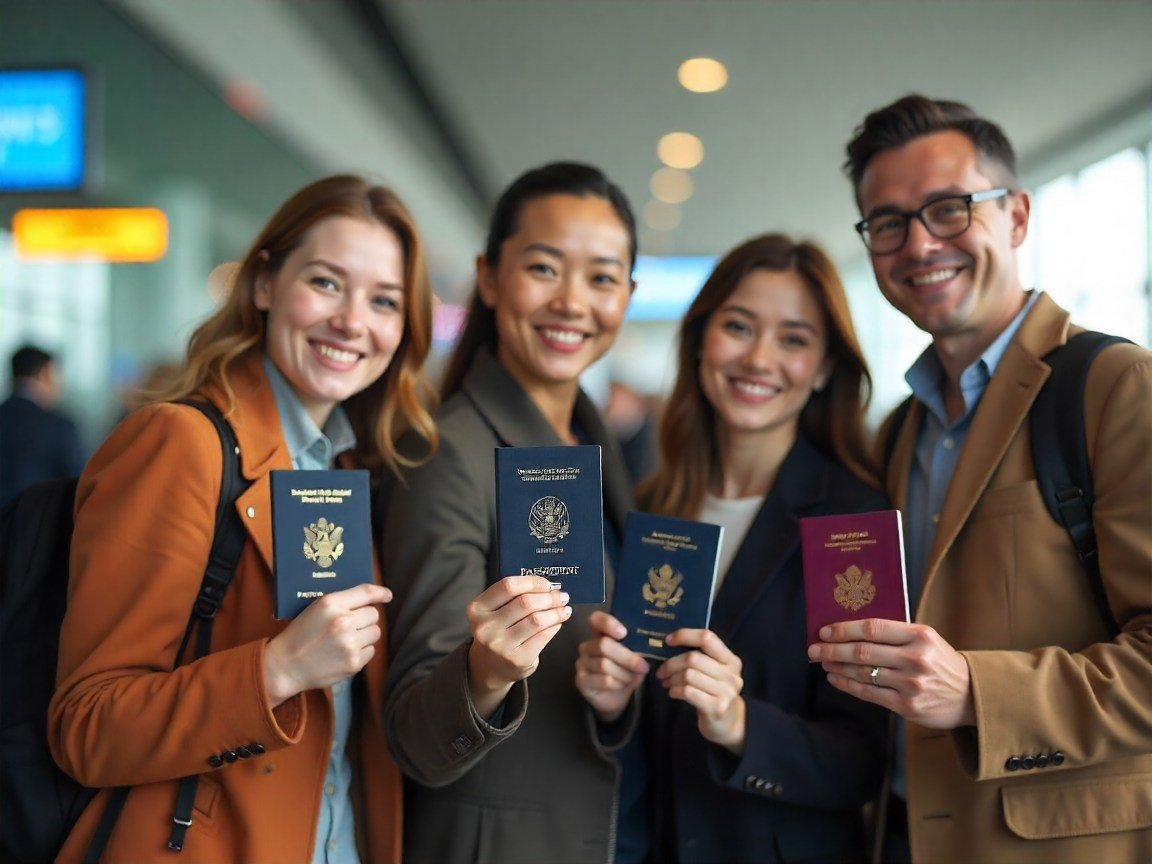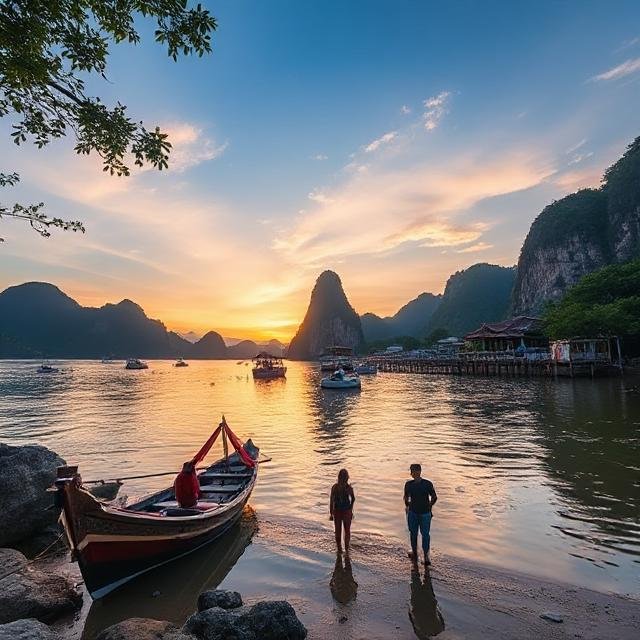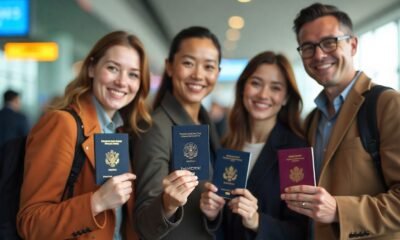Asia Travel Pulse
China, Malaysia, India, Russia, and South Korea Lead the Way as Bangkok Tops Global Travel Lists for Summer 2025

Thursday, August 7, 2025
Author: TTW News Desk
As summer 2025 draws near, Bangkok has once again emerged as one of the top global travel destinations, with travelers from China, Malaysia, India, Russia, and South Korea driving the surge in bookings. These countries are leading the charge due to a combination of factors: Bangkok’s rich cultural heritage, modern amenities, and exceptional hospitality, which continue to attract visitors seeking both authentic experiences and luxury. The Thai capital’s appeal lies in its unique ability to blend vibrant street culture with world-class shopping, historic landmarks, and sustainability-focused tourism practices. As Bangkok secures its position at the top of global travel lists, the influx of tourists from these regions underscores the city’s enduring popularity despite global challenges.
A City That Blends Tradition and Modernity
Bangkok’s lasting popularity is a testament to its ability to blend its rich cultural heritage with modern conveniences. From ancient temples and palaces to cutting-edge shopping malls and vibrant nightlife, the city offers a diverse array of experiences that appeal to a wide range of travelers. Visitors come for the authentic street food culture, bustling markets, and iconic landmarks like the Grand Palace and Wat Pho, while also enjoying world-class hotels, restaurants, and shopping destinations.
In addition to its cultural draw, Bangkok is known for its high standards of service and international safety protocols, ensuring that travelers from all over the world can experience the city with confidence. This combination of heritage, modernity, and hospitality makes Bangkok a unique and enduring favorite for global travelers.
Experiential and Sustainable Travel Trends
The growing demand for experiential travel is a key factor behind Bangkok’s continued success. Travelers are increasingly seeking destinations that offer more than just sightseeing—they are looking for deeper cultural connections and opportunities to engage with local traditions. Bangkok excels in this regard, offering visitors the chance to immerse themselves in the city’s history and culture while still enjoying the convenience and luxury of modern amenities.
Moreover, Bangkok has positioned itself as a sustainable travel destination, promoting responsible tourism practices. Efforts to protect the city’s natural and cultural resources are part of a broader push by the Thai government to ensure that tourism growth does not come at the expense of the environment or local communities. This focus on sustainability has resonated with travelers who are more conscious about their environmental impact.
Tourism Trends Reflect Bangkok’s Enduring Popularity
Thailand’s tourism statistics further highlight Bangkok’s status as a top global destination. From January 1 to August 3, 2025, the country welcomed over 19.6 million international visitors, with Bangkok continuing to be the most popular entry point. The top countries sending tourists to Thailand this year include:
China: 2,733,160 visitors
Malaysia: 2,700,103 visitors
India: 1,390,693 visitors
Russia: 1,124,467 visitors
South Korea: 918,372 visitors
China’s return to the top spot reflects a rebound in outbound travel from the region, following the lifting of pandemic restrictions. This resurgence in Chinese tourists is significant for Thailand, which has long been a favored destination for travelers from China. The steady influx of visitors from other regions, including Malaysia, India, and South Korea, further demonstrates Bangkok’s widespread appeal across Asia and beyond.
Promoting Thailand as a Global Tourism Leader
The Thai government continues to play a key role in maintaining Bangkok’s status as a leading global tourism destination. A focus on promoting sustainable tourism, preserving cultural heritage, and supporting local businesses is central to the country’s tourism strategy. Through initiatives that prioritize responsible tourism and environmental protection, Thailand is ensuring that its tourism sector grows in a way that benefits both travelers and local communities.
Additionally, the government has placed a strong emphasis on enhancing Bangkok’s image as a safe, modern, and culturally rich city that offers an exceptional travel experience. With ongoing efforts to improve infrastructure and services, Bangkok is positioning itself to remain at the forefront of global travel trends.
A Vibrant and Resilient Bangkok
Although Bangkok is commonly linked with heavy traffic and bustling streets, the city’s enduring appeal is evident in its ability to remain a leading destination for global travelers. Whether it’s exploring ancient temples, enjoying world-class shopping, or indulging in its diverse culinary scene, Bangkok offers something for everyone. The city’s ability to adapt to the changing demands of global travelers while staying true to its cultural roots ensures that it remains an exciting and relevant destination for years to come.
As global tourism continues to recover, Bangkok stands as a testament to the enduring appeal of destinations that offer a rich cultural experience, modern amenities, and a commitment to sustainability. The city’s success in attracting millions of visitors, despite the challenges of recent years, reflects its unique ability to evolve and thrive in a rapidly changing world.
Tourists from China, Malaysia, India, Russia, and South Korea are driving Bangkok’s rise as one of the top global destinations for summer 2025, thanks to its rich culture, modern amenities, and focus on sustainable tourism.
In 2025, Bangkok continues to be a beacon of cultural richness, hospitality, and innovation, making it one of the most exciting places to visit for travelers seeking unforgettable experiences.
Asia Travel Pulse
2025 Travel Breakthrough: Top Asian Passports with Verified Visa-Free Access, All You Need to Know

Thursday, August 7, 2025
Author: TTW News Desk
As global mobility steadily recovers and expands in 2025, certain Asian passports have become key enablers of seamless international travel, offering unparalleled visa-free access to a growing number of destinations. Supported by government-issued visa exemption agreements, Japan, South Korea, Singapore, Malaysia, the United Arab Emirates and Hong Kong SAR are leaders in the international community with regards to visa-free access. This document analyzes how the leading Asian passports are transforming travel in 2025, drawing from credible sources, including government ministries and consular officials.
Japan continues to be a leader in visa-free access, with entry to 72 countries and regions as confirmed by the Ministry of Foreign Affairs (MOFA). Japanese nationals enjoy short-term visa-free access to key regions across Europe, Asia and the Americas. Furthermore, Japan’s reciprocal visa recognition agreements with countries like Singapore, Malaysia and South Korea reinforce its role in fostering interconnected mobility within Asia.
The South Korean passport remains among the top-ranked in Asia, particularly due to its participation in official visa waiver programs, most notably with Japan and ASEAN member states. While the Ministry of Foreign Affairs of South Korea does not publish a complete list, Japan officially recognizes South Korea as a visa-exempt country, providing visa-free access to its citizens. Additionally, the temporary waiver of the Korean Electronic Travel Authorization (K-ETA) through 2025 further enhances South Korea’s travel prospects.
The Singaporean passport holds a significant place among Asia’s most powerful travel documents, backed by an extensive network of bilateral agreements. Although a consolidated list is not available, countries such as Japan and members of the European Union (EU) provide visa-free access for Singaporean passport holders. Singapore’s consistency in diplomacy and visa facilitation ensures its continued leadership in global mobility.
With visa-free access to over 180 countries, the Malaysian passport is another major player in Asia’s travel landscape. Official information from Japan’s Ministry of Foreign Affairs shows that Malaysian citizens hold visa exempt status which allows them to visit Japan for up to 90 days. This level of access granted reflects the strides made by ASEAN in facilitating travel within the region.
Although not part of East Asia, the UAE passport is a force to be reckoned with, offering visa-free access or visa-on-arrival access to more than 82 destinations globally, according to the UAE Ministry of Foreign Affairs. The UAE’s strategic diplomatic policies continue to unlock new travel opportunities across Africa, Asia, and Europe, positioning it as a major hub for global mobility.
Hong Kong SAR, as part of China but with its own distinct global policies, continues to provide one of the most powerful passports in Asia. Official listings from the Japanese government confirm that Hong Kong passport holders enjoy visa-free access. This autonomy in travel agreements ensures that the Hong Kong SAR passport remains a highly mobile travel document in 2025.
The year 2025 sees top Asian passports continuing to dominate global mobility rankings. These passports, underpinned by transparent visa policies and government-to-government agreements, offer enhanced visa-free access to international travel. Japan, South Korea, Singapore, Malaysia, UAE and Hong Kong SAR stand to receive tangible rewards from their strong international relations, placing their people ahead of the international travel renaissance. Through encouraged international visa-free travel, and consistent international relations, these countries serve as a model for the future of unimpeded travel in Asia and the rest of the world.
Government Sources:
- Ministry of Foreign Affairs of Japan (MOFA)
- Ministry of Foreign Affairs of South Korea
- Singapore Ministry of Foreign Affairs
- Ministry of Foreign Affairs of Malaysia
- UAE Ministry of Foreign Affairs
- Hong Kong SAR Government Official Travel Information
Asia Travel Pulse
Thailand Aims to Revive Tourism as Chinese Visitor Numbers Plummet

Wednesday, August 6, 2025
Author: TTW News Desk
Tourism in Thailand, an important pillar of its economy, is having a tough year in 2025. International tourist arrivals have fallen 5%, led predominantly by a fall in visitors from China and competition from alternative destinations in Asia.
Between January 1 and July 5, 2025, Thailand received 16.8 million international visitors, lower than 17.7 million during the same period last year. The largest decrease was from neighboring nations, which dropped by 12.2%, with East Asia also experiencing a steep 24.8% decline. The main reason being the smaller number of Chinese tourists, which dipped by 34.2% from pre-pandemic 2019 levels.
Shifting Tourist Demographics
While long-haul travelers from markets like India, Japan, Singapore, Australia, and the U.S. have increased, their numbers remain relatively small, accounting for only 28% of total arrivals. These tourists typically spend more, but their growth cannot fully compensate for the loss of Chinese visitors.
Before the pandemic, China was Thailand’s largest tourism market, supplying 28% of all international arrivals—about 11.1 million visitors in 2019. However, Chinese tourists now make up just 13.6% of total arrivals. Estimates suggest that 2025 will mark the first time in over a decade (excluding COVID-19 years) that Chinese tourist numbers fall below 5 million.
Government Measures to Revive Tourism
Tourism contributes 20% of Thailand’s GDP, making its recovery crucial. The Thai government has introduced several initiatives to counter the downturn:
1. Delaying the Tourist Fee
Originally set for 2025, the government postponed the “Kha Yeap Pan Din” fee (a 300 THB charge for air arrivals and 150 THB for land/sea entries) to mid-2026. The funds will enhance tourist facilities and provide insurance coverage for foreign visitors.
2. Subsidies for Charter Flights
To attract more visitors, authorities are offering 350,000 THB per charter flight. New partnerships with travel agencies in Chongqing, Lanzhou, and Hangzhou aim to bring an additional 150,000 Chinese tourists to Thailand.
3. Digital Entry System
Earlier in 2025, Thailand launched a digital entry system, replacing paper-based immigration checks with a faster, online registration process to improve the traveler experience.
Factors Behind the Decline in Chinese Tourists
Several key factors contribute to the drop in Chinese visitors:
1. Economic Slowdown in China
China’s economic challenges, including a sluggish property market and weaker consumer spending, have led to reduced outbound tourism. Middle-class travelers, who once fueled Thailand’s tourism boom, are now more cautious with discretionary spending.
2. Rising Competition from Other Destinations
Countries like Vietnam, Japan, and South Korea have aggressively marketed themselves to Chinese tourists, offering easier visa policies and new attractions. Japan’s weakened yen, for example, has made it a more affordable option compared to Thailand.
3. Changing Travel Preferences
Post-pandemic, Chinese tourists are favoring shorter trips and domestic travel over long international vacations. The popularity of “revenge travel” within China has also diverted potential visitors away from overseas destinations.
4. Safety Concerns and Negative Perceptions
Reports of scams targeting tourists and safety incidents in Thailand have circulated on Chinese social media, damaging the country’s reputation as a secure destination. The Thai government is working to address these concerns through tighter regulations and public awareness campaigns.
Private Sector Initiatives in Thailand
Hotels, airlines, and tour operators are also adapting to the changing market:
- Discounts and Bundled Packages – Many resorts are offering all-inclusive deals to attract budget-conscious travelers.
- Luxury and Wellness Tourism – High-end hotels are focusing on medical tourism and wellness retreats, particularly targeting European and Middle Eastern visitors.
- Sustainable Tourism – Eco-friendly resorts and community-based tourism projects are gaining traction among environmentally conscious travelers.
Future Outlook for Thai Tourism
Experts are of the view that these stimulus steps will begin yielding fruit by the end of 2025. Assuming no serious disruptions, Chinese tourist arrivals may return to 70-80% of pre-pandemic levels towards the end of 2026.
Thailand, despite present difficulties, is a leading travel destination, and the efforts of the government seek to reinstate it as a player in the international tourism arena. The emphasis currently is on diversifying sources of visitors and improving traveler convenience in a bid to develop long-term growth.
Asia Travel Pulse
Thailand’s Tourism Strategy Must Evolve to Cater to The Growing Demand for Luxury Travel in Asia Pacific

Wednesday, August 6, 2025
Author: TTW News Desk
To cater to the region’s influx of high-net-worth travelers on the hunt for premium experiences, Thailand’s tourism playbook needs a makeover. Market data reveals a new wave of middle class consumers in key markets, such as China and India, who now crave high-end resorts, exclusive experiences and luxury services. Despite regulatory constraints, the Thai government is making efforts to stay competitive by allowing integrated resorts and putting a premium on infrastructure and public-private partnerships that would attract these big-spending tourists. This change is essential for the nation to take full advantage of the wealth in Asia Pacific and guarantee long-term prosperity amid an ever more fierce tourism industry.
The tourism industry in Thailand has for many years been among the largest in Southeast Asia, and this amount continues to expand every year. With visitor numbers exceeding that threshold (CNN puts it at 40 million), a marketplace is emerging for five-star luxury tourism — that sector poised to deliver the future growth, now that the country has arguably peaked as a traditional tourist destination. However, several leading experts have urged the country to aggressively target high-end travelers from the Asia-Pacific region — a fast-growing group of potential tourists who could be key to helping restore Thailand’s tourism industry. This transition requires a focused strategy such as luxury marketing, perception branding through public-private partnerships, and investment in global standard infrastructure.
Thailand’s Tourism Landscape and Challenges
In recent years, Thailand’s tourism industry has enjoyed tremendous success, attracting millions of international visitors annually. However, after surpassing the 40-million mark, Thailand now faces new challenges in maintaining its competitive edge in the global tourism market. To remain relevant in an increasingly competitive landscape, particularly in the Asia-Pacific region, Thailand must shift its focus towards luxury tourism.
This shift is necessary not only to keep up with the growing affluence of travelers in the region but also to maintain the country’s competitive position compared to neighboring destinations such as Singapore, Japan, and emerging destinations in the Middle East. Experts argue that Thailand’s tourism sector must focus on high-end travelers, particularly those from countries like China and India, whose growing middle class is fueling demand for premium travel experiences.
Affluent Travelers and the Rising Middle Class in Asia-Pacific
The Asia-Pacific region, which encompasses some of the world’s most dynamic economies, is witnessing an influx of affluent travelers who are increasingly looking for luxury experiences. According to the Pacific Asia Travel Association (PATA), tourism in Asia-Pacific generated over 648 million regional trips last year, with projections indicating that the number of trips will reach nearly 700 million this year and 800 million by 2027. Thailand, with its rich cultural heritage, vibrant cities, and tropical landscapes, is well-positioned to capture a share of this growing market.
China stands out as a crucial market driving the demand for luxury tourism. Over 6.2 million affluent individuals and 168 million upper-middle-class consumers in China are fueling luxury consumption, both within China and abroad. As these consumers look for travel experiences that cater to their refined tastes, Thailand stands out as a prime destination for high-end tourism, offering world-class resorts, luxurious beachfront properties, and exquisite dining experiences.
However, Thailand faces challenges in attracting these affluent travelers. A significant challenge is the perception of safety, particularly due to concerns over border scams and the recent tensions at the Thailand-Cambodia border. Many governments have issued travel warnings for Thailand, which has caused some hesitation among potential travelers from key markets like China. This perception issue has had a direct impact on the country’s ability to tap into the luxury tourism sector.
The Need for Luxury Marketing and Public-Private Partnerships
To maximize growth in the luxury tourism market, Thailand needs to invest in targeted luxury marketing campaigns that focus on the affluent Asia-Pacific traveler. The country must also work on strengthening public-private partnerships to develop new infrastructure and attractions that cater to the needs of high-end visitors.
Public-private partnerships can be key to building integrated resorts, luxury hotels, and entertainment complexes that appeal to the growing affluent class in the region. Additionally, these partnerships can foster the development of experiences that go beyond typical tourist attractions, offering exclusive and immersive experiences that luxury travelers crave.
Currently, Thailand’s major tourism websites, such as the Thailand National Tourism Organization’s (TAT) website, could benefit from significant upgrades. A more user-friendly and visually appealing website would make it easier for international visitors to access important information about the country’s luxury tourism offerings. By looking at the success of other national tourism boards, such as Japan’s National Tourism Organization website, Thailand could make improvements that would better showcase its luxury offerings to potential visitors from around the globe.
The Impact of Thailand’s Entertainment Complex Bill
Thailand’s entertainment complex bill, which remains delayed, is another factor that could affect the country’s ability to compete with other countries in the region. The bill’s approval is crucial for enabling Thailand to establish the necessary infrastructure to compete in the luxury tourism market. Integrated resorts and high-end entertainment complexes have become key attractions in places like Singapore and Macau. These resorts not only provide luxury accommodations but also offer world-class entertainment, dining, shopping, and leisure activities, creating a destination that appeals to affluent travelers.
Without this bill’s passage, Thailand risks falling behind other countries in the region. For example, developments like Singapore’s Marina Bay Sands and Sentosa, or Macau’s integrated resorts, continue to set the standard for luxury tourism in Asia. Additionally, new projects in emerging destinations such as Vietnam are gaining attention for their ability to attract affluent visitors, which could further increase the competitive pressure on Thailand.
Galaxy Resorts Thailand, for instance, has emphasized the need for the bill to be passed in order to enhance the country’s competitiveness. The resort giant has expressed patience regarding the delay, respecting the government’s decision while remaining hopeful that the legislation will eventually pass to allow for future developments.
Global Competitiveness and the Luxury Gaming Sector
The battle for dominance in the luxury tourism market extends beyond accommodations and entertainment. The gaming industry also plays a significant role in attracting affluent travelers, with several integrated resorts across the Asia-Pacific region catering to high-end gaming enthusiasts.
In Macau, for example, Galaxy Entertainment Group’s Galaxy Macau is set to open a fourth phase with five new luxury hotels, retail outlets, and family-friendly attractions. The resort is focused on attracting premium customers rather than mass-market gamblers, positioning itself as a high-end destination for tourists looking for both luxury gaming and non-gaming experiences.
With Macau’s government projecting a decrease in the region’s gross gaming revenue, Galaxy Entertainment is still optimistic about its business prospects, as it targets the premium gaming sector. Its strategy aligns with a broader trend in the industry, where companies focus more on high-value customers rather than the traditional mass market.
The Role of Integrated Resorts in Luxury Tourism
The concept of integrated resorts, which blend luxury accommodations, world-class entertainment, gaming, and retail, has become a key component of luxury tourism in Asia. Thailand has the potential to become a major player in this sector, but it will require the government and private sector to collaborate on the creation of world-class resorts that can attract affluent travelers from the Asia-Pacific region.
With the entertainment complex bill still under discussion, Thailand has not yet been able to capitalize fully on the integrated resort trend. However, as developments such as Japan’s MGM Osaka and the UAE’s first casino resort by Wynn in 2027 continue to emerge, the competition in this sector is becoming fiercer. Thailand needs to act quickly to secure its place in this rapidly expanding market.
Thailand’s Strategic Position in Asia-Pacific Tourism
Despite the current challenges, Thailand remains strategically positioned as a leading destination in the Asia-Pacific region. The country’s natural beauty, rich cultural heritage, and world-class infrastructure provide a solid foundation for luxury tourism development. However, Thailand must adapt to the changing demands of the Asia-Pacific tourism market by focusing on the luxury sector, particularly targeting the growing number of affluent travelers from China, India, and other regional markets.
To ensure its continued success in the luxury tourism market, Thailand must focus on marketing strategies that emphasize the country’s unique offerings and its potential for delivering world-class experiences. Building integrated resorts, improving tourism platforms, and passing the entertainment complex bill are essential for establishing Thailand as a top destination for wealthy travelers in the Asia-Pacific market.for affluent travelers in the Asia-Pacific region.
With the rise of luxury travel in Asia Pacific, driven by affluent travelers from markets such as China and India who are seeking once-in-a-lifetime high-end experiences, Thailand’s tourism strategy needs to adapt. Thailand has an opportunity to capitalize on its long-standing reputation as a tourism leader in Asia, but it will need to act quickly and invest in infrastructure, luxury resorts and public-private partnerships that build out the region if it is wants to stay at the head of the pack.
Luxury tourism in Thailand may be at a turning point. Safety remains a concern with the entertainment complex bill still unfinished, but the country needs to step up marketing efforts and take advantage of its rich pool of high-rolling visitor sources from Asia-Pacific. Thailand will become a key global player in the premium tourism market by developing public-private partnerships, rehabilitating infrastructure, and ultimately targeting luxury markets.
-

 Brand Stories2 weeks ago
Brand Stories2 weeks agoBloom Hotels: A Modern Vision of Hospitality Redefining Travel
-

 Brand Stories2 weeks ago
Brand Stories2 weeks agoCheQin.ai sets a new standard for hotel booking with its AI capabilities: empowering travellers to bargain, choose the best, and book with clarity.
-

 Destinations & Things To Do3 weeks ago
Destinations & Things To Do3 weeks agoUntouched Destinations: Stunning Hidden Gems You Must Visit
-

 Destinations & Things To Do2 weeks ago
Destinations & Things To Do2 weeks agoThis Hidden Beach in India Glows at Night-But Only in One Secret Season
-

 AI in Travel3 weeks ago
AI in Travel3 weeks agoAI Travel Revolution: Must-Have Guide to the Best Experience
-

 Brand Stories1 month ago
Brand Stories1 month agoVoice AI Startup ElevenLabs Plans to Add Hubs Around the World
-

 Brand Stories4 weeks ago
Brand Stories4 weeks agoHow Elon Musk’s rogue Grok chatbot became a cautionary AI tale
-

 Brand Stories2 weeks ago
Brand Stories2 weeks agoContactless Hospitality: Why Remote Management Technology Is Key to Seamless Guest Experiences
-

 Asia Travel Pulse1 month ago
Asia Travel Pulse1 month agoLooking For Adventure In Asia? Here Are 7 Epic Destinations You Need To Experience At Least Once – Zee News
-

 AI in Travel1 month ago
AI in Travel1 month ago‘Will AI take my job?’ A trip to a Beijing fortune-telling bar to see what lies ahead | China













You must be logged in to post a comment Login